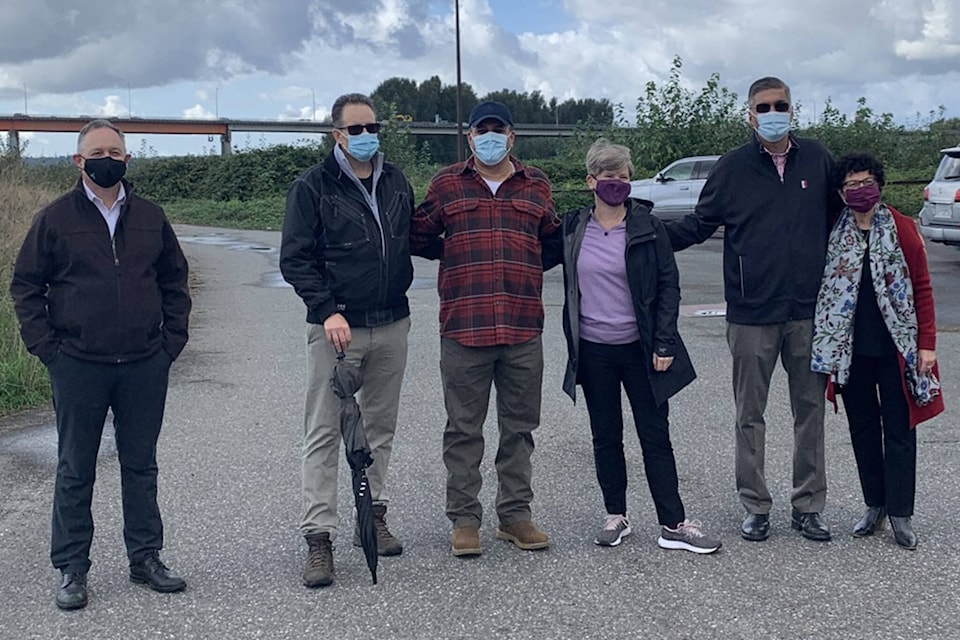Work resumed on Sept. 20 on the Fraser River sewer crossing, after two years of delays.
Government officials, including B.C. Minister of Municipal Affairs Josie Osborne, MLAs Pam Alexis and Bob D’Eith, and Mayor Paul Horn, had a meeting with property owners Kenny and Bobby Braich on Sept. 19.
“The planning is well under way and suffice to say I’m really excited about the future of this city and appreciate everyone’s time, focus and energy!” Kenny Braich said on social media.
Clearing will take place until October, followed by soil removal, dredging and pipe pulling until January, and backfilling and tie-ins will be worked in February through March, according to Jay Jackman, Mission’s manager of development engineering, projects and designs.
Work is expected to be complete by spring 2022, after years of ballooning costs and warnings about the devastating environmental consequences should a daily estimated 11 million litres of toxic sewage and waste spew downstream.
A short history:
The original 60-centimetre pipeline was built in 1983 to carry all the waste from Mission to the James Wastewater Treatment Plant in Abbotsford.
The single one-kilometre line – although just over halfway through its lifespan – is expected to reach its capacity in the coming years due to the massive growth of the community.
There are also concerns it was deteriorating faster due to its location in rough waters with frequent rock movement. Because it’s a single pressurized line, there is no way to check its current condition with cameras.
A “fountain of sewage” would flow from Mission to Richmond if the worst occurred with no immediate fix, said former mayor Randy Hawes in 2017.
READ: Mission to build new sewer line
A breach would mean the pipe would have to be shut off, backing up Mission’s sewer lines and requiring a sewage lagoon to be dug beside the race track. Hundreds of trucks would need to manually haul waste across the bridge to Abbotsford.
The city started applying to the provincial and federal governments for infrastructure grants in 2016 to twin the pipeline.
This would allow the line’s condition to be checked, and for the flow of waste to be diverted if repairs were needed.
An $8.3 million grant to build the 2,410-metre secondary line (950 metres buried in a dredged underwater trench) was approved in 2017.
The federal government would provide 50 per cent of the funding under the Clean Water and Waste Water Fund at $4.1 million, the province would provide 33 per cent at $2.7 million, while the city was on the hook for 17 per cent at $1.4 million.
MORE: Major funding needed
Including the cost of land, the total estimate was at $12 million when work began in summer of 2018.
When the on-land portion of the project neared completion in May, 2019, the price estimate had doubled to an approximately $22 million. Four months later, the price had nearly tripled to $32 million.
Construction-cost inflation had started in 2016, but cost-overruns exploded in 2018.
The falling Canadian dollar; the rising cost of U.S. steel caused by a trade dispute with the Trump Administration resulted in 25 per cent tariff, an increase in the pipe’s diameter from 75 to 90 centimetres, and the cost of environmental assessments were all given as contributing factors for the price spike, in a staff report.
An additional obstacle occurred in the summer of 2019, after the Department of Fisheries (DFO) rescinded its authorization of the river-crossing portion of the project because of a change to the Fisheries Act, which required further review.
At this point, the city was considering borrowing heavily from its internal reserves to complete the work.
Meanwhile, a dispute arose with the Braich family over the now-stalled project in 2020. The land portion of the pipeline had been installed through a section of their property, which was now being used to store the pipe waiting to be installed under the river.
October’s 2020 provincial election had promises flying from all candidates to secure the funding to complete the project. The NDP’s Pam Alexis and Bob D’Eith struck first, pledging an additional $11 million if re-elected.
After DFO authorization was approved in early 2021, the “remaining pieces began to fall in place,” Jackman said.
The provincial grant was received in April, 2021, followed shortly by the city approving a loan authorization of $12.5 million for the remaining funds.
An agreement with the Braich family was reached in July, and an $18.9 million contract was awarded to finish the project in August.
